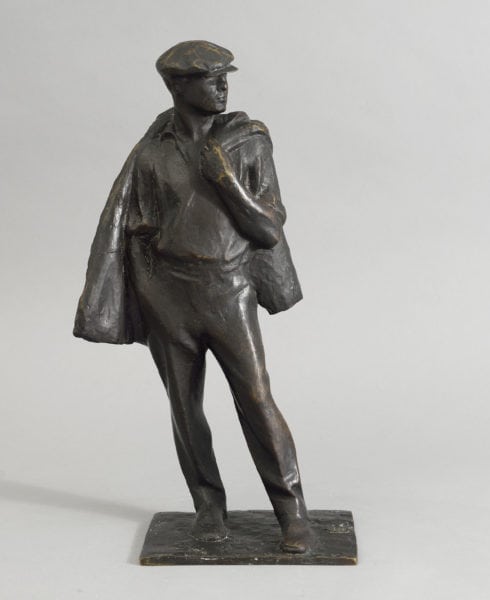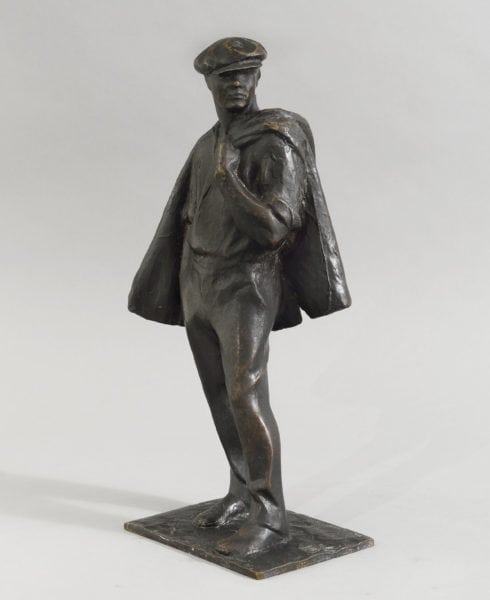Man With an Overcoat, 1913
John StorrsBronze
14 1⁄4 inches
Inscribed: To my friend Howard E. Smith
Dated: 6/12/13
Stamped by C. Valsuani Cire Perdue Foundry
Provenance
Robert Schoelkopf, New York, 1980
John Storrs is perhaps best known for his columnar, architecture-inspired sculpture made of metal and stone of the early 1920s. Yet Storrs created masterful works in many other media throughout a career spanning nearly fifty years and two continents. He began his artistic training in the United States before moving to Paris in 1911. There he formed not only artistic but also personal alliances. While in Paris, Storrs developed an early friendship with Jacques Lipchitz whom he met in art school; met and married a French writer, Marguerite De Ville Chabrol in 1914; and studied and worked with the sculptor, Auguste Rodin, with whom he remained close until the master’s death, in 1917.
Among the sculpture included in an exhibition at Folsom Galleries in New York in December of 1920, which also traveled to the Arts Club of Chicago, were Rodinesque pieces, examples of war themes as well as newer sculptures in which he expressed aspects of modern life, often working with two and three figure compositions.
In the 1920s, Storrs developed an aesthetic based on the stylization of Art Deco, using sleek metal forms that suggested skyscrapers and evoked the urban landscape. His work was included in exhibitions in Europe and America, including several organized by the Société Anonyme in New York. A 1923 one-artist exhibition at the Société Anonyme in New York, which also traveled to the Arts Club of Chicago, established Storrs as a member of the international avant-garde. Included in this exhibition were drawings along with twenty-one sculptures, and those executed after 1920 show Storrs moving more and more in the direction of architectonic sculpture. His more architectonic works, such as Untitled of ca. 1922 have been compared to the work of Jacques Lipchitz. Noted Storrs scholar Noel Frackman compares this work to Lipchitz’s Man with Mandolin, 1916-17, with its basis in figuration while architectural elements are equally evident through blocky, tower-like forms. Storrs continued to embrace modernist ideas and themes throughout the decade of the twenties. His Auto Tower marks the artist’s continued interest in the machine, a taste shared with Francis Picabia, Marcel Duchamp, Man Ray, Morton Schamberg, and others connected with Dada, Surrealism, and the Société Anonyme.
By 1938, John Storrs had received public recognition—being made a Chevalier of the French Legion of Honor–and the admiration of his peers in the art world. In 1939, at the outbreak of World War II, the Storrs family had just returned to France from a trip to America. Unbeknownst to Storrs at the time, he would never again return to America. He was arrested and imprisoned for six months in a concentration camp (Front-Stalag 122, Compiègne) in December of 1941. Storrs had enlisted as an ambulance driver for the Red Cross and had been transporting the sick and wounded in his shaky, second hand Rolls Royce. Informers had said that he had a wireless set directly connected to the enemy. Although this accusation was unfounded, Storrs daughter, Monique, was a member of the Gaullist underground in charge of French Resistance. He would again be arrested along with his daughter in 1944 because of Monique’s work in the French Resistance.
Despite the fact that he had frequently traveled between and worked in both the United States, especially Chicago, and France, Storrs lived out the remainder of his days at his home in France. Even in his later years, he continued to work in multiple media, modeling in clay and executing numerous incised and carved reliefs in addition to his paintings and drawings.
Exhibited
- Williamstown, Massachusetts, Sterling and Francine Clark Art Institute, John Storrs & John Flannagan: Sculpture & Works on Paper, November 7-December 28, 1980.
- New York, Whitney Museum of American Art, John Storrs, December 11, 1986-March 22, 1987.


